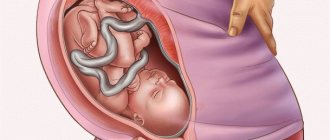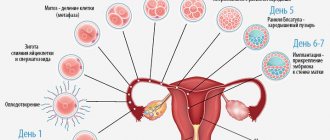For more than thirty weeks, the expectant mother gets used to her condition. The first trimester is behind us, along with endless worries and toxicosis. The next 12 weeks passed unnoticed. Many people note that the second trimester is truly a golden period in the life of every pregnant woman. And now you are already at the finish line. Soon a little miracle will be born. Once again, there is cause for concern. Discharge at 35 weeks becomes more abundant and in each specific case is individual in nature. Today we will help you figure out what is normal and in which case you need to immediately consult a doctor.
Why does discharge form?
Glandular cells, which are located in large numbers in the cervix, constantly synthesize mucus. And the intensity depends on the hormonal background. In the first phase of the cycle, as at the beginning of pregnancy, progesterone is produced. This is why the discharge becomes thick, viscous and opaque. In the second half of pregnancy, estrogen predominates. This is immediately noticeable to the expectant mother. The discharge is now liquid and quite abundant. In case of hormonal imbalances, other scenarios are possible, but these are special cases that are discussed in the doctor’s office.
After examination by a gynecologist
If you have passed the 38th week of pregnancy, then your gynecologist will certainly look at you in the chair to assess the situation, namely, the readiness of the cervix for childbirth. It is customary to evaluate it depending on the softness or dilatation of the cervix, which in obstetrics is measured in fingers. “The uterus has already opened two fingers, you can start giving birth at any moment,” says the gynecologist, and you go home waiting. And in the evening you begin to “smear” - brown discharge comes from the vagina.
One of the reasons for the appearance of brown discharge before childbirth is precisely the examination of the vagina on the gynecological chair. In this case, the cervix may be slightly injured, and small traces of blood (red, brown, brown) appear on the underwear. It's not dangerous, there's no reason to worry.
Brown discharge for this reason may be observed within or 3-4 hours after examination
You can also injure the cervix during sexual intercourse: in this case, brownish discharge can be observed for 48 hours after careless sex
Heavy discharge
Almost everyone notices this. From the first day of pregnancy, a woman begins to notice that the nature of vaginal discharge is changing. Most often they become more abundant. The fact is that after conception, the body’s functioning is completely restructured and undergoes a series of metamorphoses. Discharge changes at 35 weeks of pregnancy, but requires constant monitoring. If an unpleasant color or odor appears, you should immediately consult a doctor. It is especially important to react quickly if there is blood or pain. The norm is copious liquid discharge at 35 weeks of pregnancy. They should not be accompanied by itching, burning or an unpleasant odor.
What happens to the child
A child at 36 gestational weeks weighs approximately 2500 - 2700 kilograms and is about 45 centimeters tall, with an error of one and a half to two centimeters allowed.
Almost all life support systems and internal organs are formed and functioning at full capacity, which ensures readiness for independent life outside the mother's womb. Only some areas continue to develop, such as the nervous and immune systems.
The liver is actively preparing iron reserves, which will be used in the first year of the baby’s life for the synthesis of hemoglobin and other enzymes. The endocrine system is completing its formation, hormones are produced in the required quantities. The baby's lungs are completely ready to breathe.
To train the urinary and digestive systems, the baby swallows amniotic fluid. The substances contained in it (sugar, etc.) are processed in the gastrointestinal tract and the remains are formed into feces (meconium). The kidneys contribute to the formation of urine through blood filtration; it is excreted from the baby’s body at a rate of approximately 0.5 liters per day. The amniotic fluid is renewed every two hours, so the baby is not surrounded by its own waste.
At this stage, the baby’s constant weight gain per week is about 200-350 grams. These are mainly fatty deposits that give the body a rounded shape. The skin is smoothed out, acquires a natural shade, the fluff disappears and the cover becomes smooth.
The child develops the sucking reflex, sucking his thumb and his own fists. In the future, he needs this when grasping the nipple during breastfeeding or a bottle if artificial feeding.
The skeleton is fully formed, but does not yet have final hardness. This is necessary for a safe and traumatic passage through the birth canal, so the bones of the skull and body are still quite soft.
In general, the child has already acquired the appearance in which his mother will see him at birth. Nails and hair grew, the face acquired individual features.
Watery discharge
If you are already 35 weeks pregnant, mucous discharge on your underwear should not be surprising. Now daily sanitary pads need to be worn constantly. If you notice that they have stopped saving, then be sure to contact a consultation; there may be water leaks. There are special tests that you can buy at the pharmacy if you want to carry out rapid diagnostics. The white, watery discharge is called leukorrhea. They should not cause concern unless accompanied by other alarming symptoms.
Liquid discharge (35 weeks of pregnancy, as we see, the closest attention should be paid in this regard) at this stage is the norm. Leukorrhea is a kind of protection for the fetus that forms a mucus plug. It protects the baby from infection. Moreover, the amount of discharge will depend on the genetic characteristics of the female body. The more there were before pregnancy, the more abundant they will be during pregnancy.
Remember that now your peace of mind is the key to the normal functioning and development of the child’s body. So if the general condition does not cause concern, and the smear analysis does not show pathologies, then there is no need to worry about transparent watery discharge.
Pregnancy 37 week
Your baby's sizes:
Another week of full readiness - 37 weeks of pregnancy! If this is your first pregnancy, then most likely you will reach the fortieth week and give birth as planned. If you already have children or you are carrying twins, then birth may occur at 37 weeks.
But they are not premature. From this period, your pregnancy is considered full-term according to medical parameters.
37 weeks of pregnancy - fetal weight
At 37 - 38 weeks of pregnancy, the baby is ready to be born. Childbirth at 37 weeks of pregnancy is a common occurrence in obstetric practice.
He even strives for this - all the systems of his body are ready to start working, the hormone cortisone develops, which promotes the maturation of the lungs, a little meconium (the first feces) has accumulated in the intestines, the baby’s belly and head are approximately the same in circumference.
The baby's height during this period is 48–50 cm, the weight of the fetus is 2.8 -2.9 kg, just what we are used to seeing after babies are born.
The body continues the development process, all nerves are covered with a protective sheath, this will continue after birth throughout the first year of life.
The cartilages of the ears and nose harden, and there is a “hairstyle” on the head. During this period, the hairs grow to 0.5 - 4 cm.
Lanugo (fluff on the body) should disappear, vernix may be distributed throughout the baby’s body, or may remain only in the folds.
37th week of pregnancy - sensations
At 37 weeks, signs of imminent labor may appear: release of the mucous plug (yellowish discharge with streaks), lowering of the abdomen (the baby is about to leave), slight dilution of the stool.
Your uterus has reached its maximum size: it weighs about a kilogram, its volume is 4–5 liters. Its apex is now 37 cm from the pubic symphysis and 16–17 cm from the navel. The pressure on the bladder also increases, shooting pain in the legs and perineum is possible, the back ache, the stomach hardens several times a day.
The placenta, whose role is about to fade away, is aging. The baby will be born soon, and she will be “born” after him. The midwives confirm the delivery of the baby's place and the successful completion of the birth - there is nothing unnecessary left in the mother's body.
37th week of pregnancy: discharge
At this stage, women expecting babies may notice yellowish or even brown discharge, sometimes streaked with blood. The consistency of the discharge is a viscous mixture. Characteristic for the 37th week of pregnancy: pinkish-yellowish discharge and cloudy mucus - all these are the first signs of the release of the mucus plug blocking the entrance to the cervix.
37th week of pregnancy: the belly turns to stone
If you often diagnose yourself that at the 37th week of pregnancy: your stomach becomes stiff or periodic pain occurs, then it is better to tell your doctor about it.
At this stage, the uterus may be hypertonic, which often contributes to premature birth. Another harbinger of imminent labor may be a drooping of the abdomen.
Listen to yourself - be careful, at 37 weeks of pregnancy - sensations may become completely different.
What do you say, doctor?
This week, the doctor examines the vagina to make sure there is no (or presence) leakage of amniotic fluid, determines how soft and thin the cervix has become
The degree of its disclosure will not be ignored. It is very possible that she has already begun to open up.
During childbirth, the cervix effaces so much that its walls become very thin, allowing the baby to pass through the birth canal. Experienced obstetricians usually determine the degree of dilatation “by their fingers.” Open to 4 fingers means: 4 centimeters. But before labor begins, the cervix does not dilate more than 1 finger.
Another important point of the medical examination: at the 37th week of pregnancy, the doctor determines the presentation of the fetus and assesses the width of your pelvis.
Childbirth at 37 weeks of pregnancy
The inexorable approach of the time of birth causes excitement and slight anxiety in the mother. “How will everything happen? How will I feel? Will everything be okay? I want everything to happen quickly and without pain. I want not to feel anything” - this is a set of natural experiences and thoughts of an expectant mother who is reaching her final weeks.
There is no need to instill fear in yourself and there is no need to stress yourself out. You need to set yourself up so that you clearly understand: you need to do the work. A very difficult, but very important and most honorable job in life. Focus on the most joyful of thoughts: you will see him (her) soon - and don’t be afraid of anything!
Habitual leucorrhoea
White discharge at 35 weeks of pregnancy should be a reason for an immediate visit to the doctor. However, thick mucus can only be a sign of changes occurring in the female body. After all, such discharge is typical for the beginning of pregnancy. By the third trimester they become more liquid, although they may retain their previous appearance.
White discharge at 35 weeks of pregnancy also often indicates a number of different diseases. All of them require medical intervention, and timely one. We will try to describe the symptoms in as much detail as possible to make it easier for you to navigate. However, they are very similar to each other, so it is important to inform your doctor and not go to the pharmacy for an advertised drug.
Harbingers of childbirth
As already mentioned, labor may well begin at 37 weeks, so every mother needs to be mentally prepared for this. The characteristic precursors have already been discussed above, so let’s just briefly summarize. Firstly, this is a prolapse of the abdomen. Usually, by the time labor begins, the baby begins to behave noticeably quieter, the so-called. the calm before the storm. Secondly, the harbingers include the passage of the plug, after which you can expect childbirth in a few days or a couple of weeks. Thirdly, a boost of energy. The expectant mother feels a surge of inexhaustible energy, she suddenly feels the urge to do spring cleaning, etc.
Also a characteristic harbinger is the release of water, which can occur during contractions that have already begun or long before them. If fluid flows down your legs, you need to urgently go to the maternity hospital without waiting for contractions. The birth of the baby should occur no later than one day after the passage of amniotic fluid. Sharp painful contractions of the uterus - contractions - are also evidence of approaching labor. If they have begun, then in the next few hours the long-awaited meeting with the baby will take place.
So, 37 weeks pregnant. No matter what kind of discharge the patient has, any smudge on her panties should be a reason for an obstetric consultation. It’s better to be branded as an overly meticulous alarmist than to miss and leave without proper attention a real threat to the baby’s health.
Bacterial candidiasis
Discharge at 35-36 weeks of pregnancy may be associated with the activity of this fungus, which is common and familiar to the entire female half of humanity. It is quite simple to distinguish it, although each disease progresses differently. First of all, an unpleasant odor indicates thrush. If the discharge has acquired a curdled form, you should urgently get tested and then undergo treatment.
If the disease develops quickly, you will soon feel itching and burning in the genital area. This disease is not dangerous to the mother's health, although it is unpleasant. However, it is very important to treat it before delivery. The fact is that mucous membranes affected by candida become loose, which contributes to ruptures during childbirth. In addition, this fungus enters the baby’s oral cavity during the birth process, which is fraught with its own troubles.
What will an ultrasound show?
This examination is no longer done routinely; it can only be prescribed when the doctor needs to clarify:
- fetal weight;
- degree of maturity of the placenta;
- amount of amniotic fluid;
- is there any entanglement of the umbilical cord;
- presentation.
Depending on the data obtained, obstetricians develop delivery tactics. In the photographs taken during an ultrasound, future parents see the child as he will be born: the facial features are already fully formed, only the skin remains red and slightly wrinkled. But the skin will acquire a normal color only after birth.
Colpitis
Yellow discharge at 35 weeks of pregnancy may indicate the development of inflammation of the vaginal mucosa. The causes are various microorganisms: streptococci, staphylococci, mycoplasma, hemophilus influenzae. If heavy discharge at 35 weeks of pregnancy becomes a source of unpleasant odor and acquires a purulent tint, then, most likely, cervical erosion is occurring.
The disease is very serious, which threatens with the most serious consequences. In early pregnancy, it can lead to pathology of fetal development and miscarriage. Colpitis often causes infection of amniotic fluid and premature birth.
Necessary examinations
In connection with preparing for childbirth, a woman does:
- measurements of the abdomen and pelvis;
- weighing (the pregnant woman should gain no more than 13 kg by this time);
- CTG (checks the fetal heartbeat and the ability of the uterus to contract).
In addition to routine tests, a pregnant woman can be checked for:
- hemoglobin (if anemia is suspected);
- sugar (must be taken from women over 25 years of age or if there is a hereditary predisposition to the development of diabetes).
Other laboratory tests are also possible, which are prescribed taking into account the condition of the pregnant woman.
Vaginosis
This is a non-inflammatory disease, which is characterized by changes in the microflora of the vagina, the death of lactoflora and the colonization of the mucous membrane by anaerobic microorganisms.
This disease can develop during pregnancy and lead to complications during childbirth. At the same time, it is quite difficult to diagnose, since there are no clear symptoms. The nature of the discharge remains virtually unchanged, but it takes on the smell of rotten fish. If you are sensitive to such nuances, then catch the changes at the very beginning and consult a doctor in time.
Genital herpes
This is another reason for the appearance of heavy discharge. During pregnancy, the immune system weakens, which means that this disease has every chance to manifest itself. In addition to heavy discharge, symptoms of herpes include a rash and sores on the genitals, as well as itching and burning. There is a high probability of infection of the fetus. If the disease is detected at a late stage, delivery by caesarean section will most likely be offered.
Allergic reaction
It may seem incredible, but white discharge is often caused by the sanitary pads that we wear every day. Moreover, the likelihood of developing an allergic reaction is greater if they contain a variety of plant extracts and additives. Therefore, it is better to choose proven hygiene products, without fragrances.
Be sure to buy yourself a set of natural linen. It will be useful to you throughout your pregnancy. Avoid wearing synthetics. Take a shower at least twice a day; these simple measures can reduce the likelihood of developing many diseases.
Amniotic fluid or urine leakage
The last trimester of pregnancy is your chance to enjoy the little miracle in your belly. Now the baby is already big, his head puts pressure on the bladder, so when coughing, sneezing and laughing, watery discharge is observed. This has nothing to do with amniotic fluid. The child is simply putting pressure on the bladder.
At 35 weeks, watery discharge may be amniotic fluid. They have a yellow tint and a sweetish smell. It is very easy to confuse it with accidental urination. However, if you feel pain or discomfort, be sure to call an ambulance. The hospital will do a special test and determine the nature of this phenomenon.
Everything described above is subject to correction, the most important thing is to consult a doctor in time. Do not self-medicate, because your baby’s health depends on it.
Is sex possible?
As a rule, at 36 weeks women do not experience sexual desire, but if there is a desire and there are no contraindications, then sexual activity is allowed before childbirth. You just need to avoid deep penetrations and pressure on the stomach.
Contraindications for having sex will be:
- Tendency of the uterus to hypertonicity. Orgasm will further increase uterine tone and can cause early labor.
- Multiple pregnancy. For mothers of twins, sexual contact is prohibited almost throughout the entire pregnancy.
If you have doubts about your condition (abdominal pain, changes in vaginal discharge), then it is better to refuse sex.
When you need to urgently seek help
Today we want to take a brief excursion so that you know exactly which discharge (at 35 weeks of pregnancy, as we see, almost a full “set” of them is inherent) is an alarming signal that cannot be ignored. The expectant mother should not rely on chance, and with every problem, contact a specialist who will assess the state of health. However, transparent and white discharge is most often a variant of the norm, even if it is accompanied by a sour odor, it still does not pose a threat to the life and health of the baby and mother. But a change in color almost always indicates a pathological process that needs immediate correction.
Peculiarities
Discharge should not be underestimated. Vaginal secretions are produced by epithelial cells of the cervix. At different stages of pregnancy, they can tell a lot about the condition of the expectant mother and fetus. Immediately after conception and until the 8th–9th week of pregnancy, a woman’s discharge is normally quite scanty, and sometimes almost completely absent. This is the effect of progesterone, which carries out the basic preparation of the body for long-term gestation.
From the 10th week, vaginal secretion becomes more abundant, and by the end of pregnancy it is not only abundant, but also thin. This is how the hormone estrogen acts on vaginal secretion. The task of the secretory function of the female reproductive tract is to maintain a healthy, stable microflora. The genital tract will be the first place where the baby ends up during the birth process after it leaves the uterine cavity. The health of the baby depends on their health.
Existing medical literature describes normal discharge during pregnancy as light-colored, odorless, or having a slight sour-milk odor. Other variants of the norm are also being considered, but only under certain conditions and for certain periods.
Brown discharge is no exception. Not only can they indicate dangerous complications, but they can also be a natural variant of normal vaginal secretion. The brown color of the discharge is given by erythrocytes - blood cells. This means that brown discharge is a type of blood discharge.
A small amount of blood in the discharge in the very early stages may be the norm when a fertilized egg is implanted into the uterine cavity. This phenomenon is called implantation bleeding. It occurs due to a violation of the integrity of the endometrium during the attachment of the blastocyst. One of the options for such natural bleeding may be light brown discharge in a small amount approximately 8-9 days after the expected conception (or after ovulation - for ease of calculation).
Brownish spotting on panty liners or underwear is not long-lasting. Usually within a day or two there is no trace left of them. There is nothing alarming about this phenomenon.
In addition, such an early sign of pregnancy does not appear in every woman. You should know that the appearance of dark brown discharge with clots before the delay can hardly be considered a sign of implantation. Rather, we are talking about a hormonal imbalance in which menstruation began ahead of schedule. During the first 2–3 months of pregnancy, yellow-brown, moderate or scanty discharge may be a consequence of global hormonal changes.
Progesterone raging in the body of the expectant mother usually gives the vaginal secretion a yellowish tint; brown “notes” in it can appear due to high or low levels of progesterone, due to the vulnerability of the genital tract due to looseness under the influence of hormones. Normally, such discharge occurs without pain, it does not contain inclusions or impurities, or streaks of blood, and does not bother the woman. They usually stop after the expectant mother’s body has fully adapted to the new situation and circumstances.
In the later stages (a week or two before the expected date of birth), a woman may notice the appearance of brown, streaked discharge. They are usually accompanied by the secretion of mucus in small quantities or a rather impressive mucus clot. In this case, we are talking about the removal of the mucous plug, which during pregnancy closed the cervical canal and prevented the penetration of anything foreign and dangerous into the uterine cavity where the baby grew.
The removal of the plug is a harbinger of an imminent birth. He also does not need treatment.
Small brown discharge after sex or a doctor’s examination is also normal. Their reason lies in the extreme vulnerability of the pregnant woman’s genital tract. Under the influence of progesterone, they become loose and vulnerable to even minor mechanical stress.
Such discharge usually does not last long - no more than a day, and is not accompanied by any unpleasant sensations or additional symptoms. There are no clots in them, they do not intensify, their number changes in a descending manner. These are the three main reasons why brown discharge can be considered normal. All other situations, alas, relate exclusively to pathological ones.
Greenish discharge
This is a sign of a bacterial infection. They may bubble or look like a thick dough, but in any case this is an alarming symptom. Often the discharge is accompanied by an unpleasant odor. To determine the cause, the doctor must take a smear for analysis. This is an alarming symptom, so do not put off your visit to the doctor. This phenomenon is typical for a number of problems:
- these are inflammations of the genitourinary system (fallopian tubes, appendages, vagina or cervix);
- sexually transmitted diseases;
- bacterial infections;
- microflora disorders.
Only by knowing exactly the nature of the phenomenon can we give recommendations regarding treatment, so we will not stop and consider what other options there may be.
Pathological discharge during pregnancy
So that you have an idea of what you should talk about first, we will give a description of the most common pathological discharges:
1. Brown
Brown discharge always indicates a threat of miscarriage before 22 weeks and a threat of premature birth between 22 and 36 weeks 6 days. Brown discharge is coagulated blood, and if treated promptly and with adequate treatment, the prognosis can be favorable and the pregnancy can be maintained.
2. Bloody
Bloody discharge is a sign of an active pathological condition (incipient miscarriage, abortion in progress, chorionic detachment before 22 weeks; onset of premature labor, abruption of a normally located placenta, bleeding with placenta previa over 22 weeks). The prognosis for obvious bleeding is more dire. The sooner a pregnant woman contacts the nearest maternity facility, the greater the chance of a favorable outcome for the mother and fetus.
3. Pink, cream
Pinkish, beige discharge may be a precursor to the appearance of bloody discharge. Therefore, if such discharge appears, immediately contact your obstetrician-gynecologist to clarify the condition (gynecological examination, ultrasound, cardiotocography, Dopplerometry depending on the period).
4. Yellowish, yellow, green, greenish, gray in color. The nature of the discharge is thick (even discharge in “crumbs” or “pieces”), watery, foamy, and may contain lumps of mucus, flakes, etc. Typically, such discharge is a sign of infection.
The discharge can be moderate or profuse, have a different smell (sour, putrid, fishy) and be accompanied by complaints (itching, burning in the perineum, swelling, redness of the external genitalia). These are discharges that directly indicate the development of the inflammatory process. Pregnant women always have a decrease in immunity, this is due to nature and serves to prevent the mother’s body from rejecting the fetus (since the fetus is, to some extent, also a foreign organism, half of the genetic material is paternal). But in addition to the benefit, decreased immunity entails a greater risk of any inflammatory diseases, in particular colpitis (inflammation of the vaginal mucosa).
The cause of the inflammatory process may be:
— coccal flora (excessive proliferation of conditionally pathogenic microflora of the vagina or introduction of coccal flora from the external genitalia and skin if personal hygiene rules are not followed)
- Escherichia coli (introduced from the anus due to improper care)
- Trichomonas (sexually transmitted protozoa)
- gonococci (cause gonorrhea, sexually transmitted)
- chlamydia (intracellular microorganisms, also sexually transmitted)
— ureaplasma, mycoplasma (may be present in the opportunistic microflora of the vagina, or may be introduced from the outside)
Colpitis during pregnancy is subject to treatment, external treatment (ointments, creams) is allowed from early stages, local treatment (suppositories, vaginal tablets, creams and gels) is allowed from 12 weeks, a limited range of drugs is allowed.
Also, during pregnancy, bacterial vaginosis often occurs, which is characterized by an imbalance of beneficial and opportunistic vaginal microflora and requires treatment.
Under no circumstances should you select a drug on your own; not all drugs are allowed during pregnancy; there is a dependence on the duration of pregnancy and the type of pathogen, the nature of the smear. The drug and duration of treatment are determined by the obstetrician-gynecologist leading your pregnancy.
5. White, cheesy discharge
Most often, such discharge indicates the development of candidiasis, which is associated with hormonal changes and a decrease in local immunity. Treatment is indicated after 12 weeks; the choice of drug and duration of treatment is determined by your doctor.
6. Thin, watery, copious discharge
They may indicate leakage of amniotic fluid; in up to 37 weeks of pregnancy this is an unfavorable phenomenon, therefore it requires clarification of the situation and the choice of further treatment tactics (tactics vary significantly at different stages of pregnancy).
Next, we will look at discharge (normal and pathological) by obstetric week.
Yellow discharge
This is not always a clear sign of an inflammatory process. Doctors say that leucorrhoea can also have a yellowish tint. If the pregnant woman does not experience discomfort or pain, then most likely nothing bad is happening in the body. The reason for this change may be hormonal imbalances, stress or depression.
Abundant yellow discharge often indicates an allergy. If you are prone to such reactions, then you need to take a closer look at your diet and also change your hygiene products. Severe yellow discharge with accompanying pain may be a sign of an inflammatory process in the ovaries or fallopian tubes.
Yellow discharge at 35 weeks of pregnancy most often indicates the passage of a mucus plug. This does not mean that it is time for you to go give birth. It may take a few more weeks for your body to complete its final preparations. However, at your next consultation, be sure to inform your local gynecologist about your observations.
Lifestyle and preparation for childbirth at 36 weeks of pregnancy
- No matter how much you would like to lie in bed for the last weeks before giving birth, you need to go for a walk every day. Fresh air is simply necessary for the baby, and a walk will help you relax and tune in to a positive mood;
Read the article on the topic: Walking during pregnancy>>>.
- By the 36th week, it’s time for you to go on maternity leave, since childbirth can occur any day;
- At 36 weeks of pregnancy, you should already have all the tests in hand and an exchange card issued. You always carry the document with you, and at home you should have a bag packed with the necessary things for the maternity hospital and the first clothes for the baby;
- At this time, it is not recommended to leave the city, since labor can begin at any time;
- If this is not your first birth, think about who your older children will stay with while you are in the maternity hospital.;
- At 36 weeks of pregnancy, fetal development is already at the final stage and all planned ultrasounds have been completed.
However, if entanglement is suspected, an unscheduled ultrasound may be prescribed at 36 weeks of pregnancy to rule out the possibility of suffocation and decide how the birth will take place: naturally or through a caesarean section.
Starting from week 36, you will be invited to see a doctor every week, for monitoring:
- weight of the child and mother;
- at 36 weeks of pregnancy, a specialist measures the height of the uterus and abdominal girth;
- listens to the baby's heartbeat;
- measures your blood pressure;
- One of the mandatory tests is urine for the presence of protein.
Nutrition
During the prenatal period, your diet needs to change. If earlier the emphasis was on proteins, then from week 36 it is advisable to switch to a lighter diet: fish, eggs, kefir, cheeses; Your ideal food during this period is vegetables and fruits, they are quickly absorbed and also quickly excreted, while the intestines are not loaded, and you are full; If you have signs of labor, it is better to refuse food. Firstly, pain can provoke vomiting, and secondly, a full intestine interferes with childbirth, and even after it it will be difficult for you to go to the toilet; Drink more water, green tea, vitamin juices, but not before bed, otherwise swelling cannot be avoided
Read more about edema during pregnancy>>>; Please note that at this stage you should stick to five or six meals a day, with the most nutritious and high-calorie dishes from your diet in the morning, and fruit or light yogurt in the late afternoon.
Useful tips
If you decide to go to the maternity hospital with your husband, then watch together the seminar Childbirth without pain: 10 techniques for relieving pain during childbirth>>>;
Teach him these simple ways to relieve pain during contractions. So, if the lower back hurts at 36 weeks of pregnancy, during childbirth this part may hurt even more.
Ask your partner to massage the indicated area clockwise with the back of your fist.
- If you are still at home during the first contractions, take a warm bath or shower, this will help you relax, and along with this the discomfort will go away;
- When packing your bag for the maternity hospital, stock up on clothes for your baby in several sizes. Doctors' predictions regarding the baby's weight are not always one hundred percent accurate. The site has an article on this topic: Dowry for a child>>>;
- Use cosmetics for pregnant women. Your skin is vulnerable now, especially around the tummy. Don't forget to put your makeup bag in your hospital bag;
- Start preparing not only for childbirth, but also for caring for your baby. It's time to watch a seminar about the first months after childbirth, so that you can deftly handle your baby already in the maternity hospital: Happy motherhood: a technique for gently caring for a baby>>>.
- Physical preparation for childbirth
- How to overcome the fear of childbirth?
Pink or beige leucorrhoea
Every pregnant woman knows that if marks on her underwear turn red, she should immediately run to the doctor. What does barely pink discharge mean? 35 weeks of pregnancy is already the eighth month, which means you can calm down. Even if labor begins right now, doctors may well be delivering your baby. However, we need to figure out what such a phenomenon means.
In most cases, this is the plug coming off. It is her mucus that colors the discharge soft pink or beige. This phenomenon does not pose any danger. If the intensity of the color does not change, the woman does not experience pain, then calmly finish your term. The plug may come off gradually; some people give birth after this only at 42 weeks. But now you need to be on your guard, since labor can begin much earlier. It wouldn't hurt to notify your doctor.
Recommended Posts
January 28, 2011 MAGAZINE37 weeks of pregnancyYour pregnancy calendar shows as many as 37 weeks! The baby is still growing, although there is clearly not enough space in the uterus for him. Now he is still accumulating fat. After all, having been born at 37 weeks of pregnancy, the baby will not yet be able to properly regulate its body temperature. The 37th week of pregnancy creates a protective sheath around your baby's nerves. This will last throughout the first year of his life, and will contribute to better coordination of movements.
We hope that your baby has taken the correct position in the tummy, but even if the doctors found out that the presentation is breech, this does not mean that you will have a caesarean section. When you are 37 weeks pregnant, go to the women's forum. There you will certainly...
March 2, 2011 MAGAZINE37 weeks of pregnancy - the baby is getting stronger Your pregnancy calendar shows as many as 37 weeks! The baby is still growing, although there is clearly not enough space in the uterus for him. Now he is still accumulating fat. After all, having been born at 37 weeks of pregnancy, the baby will not yet be able to properly regulate its body temperature. The 37th week of pregnancy creates a protective sheath around your baby's nerves. This will last throughout the first year of his life, and will contribute to better coordination of movements.
We hope that your baby has taken the correct position in the tummy, but even if the doctors found out that the presentation is breech, this does not mean that you will have a caesarean section. When you are 37 weeks pregnant, go to the women's forum. There you will certainly...
November 29, 2020 MAGAZINE37 week of pregnancy37 week of pregnancyPregnancy at the border between 36 and 37 weeks, whether it is the first, second or third birth, acquires new properties: the child is already ready for birth, and his body is still changing and preparing for childbirth. The amount of subcutaneous fat increases, the nervous system is strengthened. The body creates a special shell to preserve the nervous system, which will be strengthened throughout the year. A surfactant is produced in the lungs, which will allow it to breathe oxygen freely. Due to the rapid gain of adipose tissue, the baby’s weight increases; at week 37 he weighs approximately 3000 grams. The woman will finally feel relief: breathing improves, food is digested without difficulty…
Current posts
photo of a child at 20 weeks of pregnancy is it possible to ask a gynecologist to puncture the bladder?
Brown discharge
This is an alarming sign that may portend premature birth. Of course, the child is already viable, but it is better if he stays in the womb a little longer. Doctors call natural delivery at this stage pathological. Therefore, brown discharge at 35 weeks of pregnancy should cause an immediate call to the ambulance. Doctors will try to delay the onset of labor for a few more weeks. However, the expectant mother will have to remain in the hospital until she begins to push.
Brown discharge at 36, 38 and 40 weeks is an expected sign of labor, which is a consequence of the passage of the plug. However, immediate examination by a specialist is necessary. Similar discharge can accompany placental abruption, damage to the cervix and a number of other disorders. Don't risk your health.
Brown discharge at the beginning of pregnancy
At the very beginning of gestation, a brown “daub” is considered a normal variant.
In the first weeks, such discharge is often caused by the process of implantation of the fertilized egg. During it, small vessels may be damaged or a small amount of the mucous membrane of the uterine epithelium may be rejected, which leads to discharge.
The cause of discharge that is not life-threatening to the unborn baby may be erosion of the cervix. It is often asymptomatic, and if a woman does not undergo regular examinations, she may not even know about it.
The affected epithelium can be injured during a vaginal examination, taking a mask, or during active sex. As a rule, doctors postpone treatment of erosion until the postpartum period.
What other reasons can cause “daub” in the early stages:
- hormonal imbalances;
- inflammation or STDs;
- miscarriage;
- frozen pregnancy;
- gene mutations;
- ectopic pregnancy.
Hormonal imbalances
This happens rarely and is considered normal. At the beginning of pregnancy, the level of sex hormones changes. If there is a failure during this process, then brown and even bloody discharge is possible.
They usually coincide with the date of menstruation, but last no more than two days. To make sure that the cause is a hormonal imbalance, you will need to consult a doctor.
Brown discharge in the early stages can be caused by an STD or inflammation of the appendages or uterus.
In the first case, they are accompanied by pain or cramping in the lower abdomen. In the second - itching, a feeling of discomfort in the vagina, an unpleasant odor.
Miscarriage
Unfortunately, most often brown spotting during pregnancy is associated with spontaneous abortion. A dangerous situation will be described as:
- nausea;
- bouts of vomiting;
- pain in the lower abdomen.
If at least some of the symptoms coincide, you need to call an ambulance. You will need special treatment in a hospital setting and bed rest.
Due to the changed hormonal status, the fertilized egg begins to exfoliate, resulting in damage to the endometrial vessels. A woman begins to have brown discharge mixed with blood, indicating a threat of pregnancy.
The death of an embryo can be caused by various factors - genetic, viral, bacterial infections.
Two or three days after this, dark discharge may begin. During a frozen pregnancy, the following is also observed:
- cessation of toxicosis;
- the feeling of swelling and mild pain in the chest stops;
- nagging pain begins in the lower abdomen.
With such symptoms, consultation with a doctor and hospitalization is necessary. If the body cannot reject the fetus, then it is necessary to carry out “cleansing”.
Gene mutations
The so-called hydatidiform mole occurs when one egg is fertilized by two sperm at once. The phenomenon is rare. Pathology can also occur if fertilization occurs with a sperm with a double set of chromosomes.
As a result, the embryo either has more chromosomes than needed, or the usual number, but they belong to the father.
Because of this, the placenta is not able to fully develop. Instead, a tumor forms on the wall of the uterus, and then the embryo dies in the first week. If only part of the placenta is affected, pregnancy may last until the second trimester. Sometimes it is possible to bear a healthy child.
The pathology is manifested by brown or bloody discharge. A woman may experience migraines with attacks of nausea.
If the fertilized egg is attached to the wall of the ovary or in the fallopian tube, the pregnancy cannot be fully termed. This condition is life-threatening for a woman.
Bloody issues
This is the most dangerous symptom that should cause immediate hospitalization. This phenomenon is extremely dangerous for the life of the mother, not to mention the baby. Bloody discharge at 35 weeks of pregnancy may indicate placental abruption. In this case, you do not have to do anything on your own. Try to lie down and relax, and immediately call a medical team. Any tension or excitement can provoke an increase in uterine tone, which will only worsen the condition.
When to call an ambulance
During pregnancy, a number of life-threatening conditions for a woman are accompanied by scarlet discharge. This is often how bleeding starts.
When urgent medical attention is needed:
- severe pain in the lower abdomen or uterine area;
- heavy, increasing bleeding;
- chills, fever;
- weakness, drowsiness;
- fainting or dizziness.
Brown discharge is a reason for an unscheduled visit to the gynecologist.
The second trimester is a time when any bleeding poses a danger to the well-being of the expectant mother and baby. There are two main reasons for such conditions: placental abruption and placental previa.
Placental abruption
Veronica, 24 years old: “I noticed brown discharge at 20 weeks of pregnancy. At the same time, my lower abdomen aches strangely. Recently I stumbled and fell, hitting my stomach quite hard. What could it be?"
Olga, 36 years old: “I’m 36. I’m expecting my first baby. Hypertensive. There was placental abruption at 10 weeks, then at 16 weeks of pregnancy. Today, at lunchtime again, there was a strange feeling in the lower abdomen, followed by brown discharge (like menstruation, maybe a little less). They took me away in an ambulance. Detachment again. Term 22 weeks. How does this threaten the child?
Inna, 26 years old: “I started bleeding heavily at 25 weeks of pregnancy. He was urgently hospitalized. A 50% placental abruption was diagnosed. The doctors said that now I will be in the hospital under observation all the time. Is this condition really so dangerous?
Placental abruption is a dangerous condition that causes brown discharge in the second trimester, which ends at 28 weeks of pregnancy. In women, abruption is often accompanied by severe bleeding, and the fetus, when this pathology develops, experiences hypoxia and a lack of nutrients, because the placenta does not perform its functions.
There is also a feeling of tension and pain in the lower abdomen. Detachment can be triggered by injuries, arterial hypertension, short length of the umbilical cord, and the presence of scars on the body of the uterus. This condition is extremely insidious and requires emergency hospitalization, and sometimes surgical intervention, since after bleeding of this kind the death of the fetus is possible.









